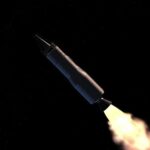
The Air Force plans to award a contract sometime between July and September of 2020 to build the U.S.’ next nuclear-tipped, intercontinental ballistic missile, the service said Tuesday. The Air Force plans to buy more than 600 Ground Based Strategic Deterrent (GBSD) missiles, about 400 of which will go into silos starting in 2028 or so to replace the aging, Boeing-built Minuteman III fleet. Either Boeing Co. [BA] or Northrop Grumman [NOC] will design GBSD. The planned GBSD Engineering and…

 By
By 











